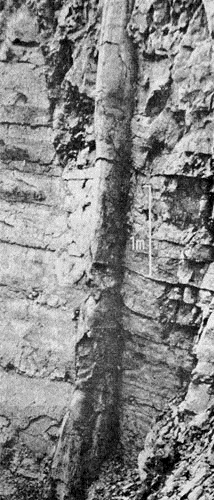|
Polystrate fossils extend across more than one layer of rock - "poly" meaning "many", and
"strate" from the word "strata", meaning "layer". The image to the right is an example of a
polystrate fossil, which is a fossilised tree that crosses several different layers of rock.
They are more common than you might think - especially as some rock layers are only
millimetres thick. Fossil trees are often found extending through more than one layer of rock,
along with animals such as Calamities (reed shaped creatures) or even catfish, such as those
found within the Green River Formation, Wyoming, USA.
This poses a big problem for the evolution model: if the layers have formed over millions of years,
then how did the polystrate fossil form? The organism would have died when the initial layer
formed, for example, a sandstone layer at the bottom of a lake surrounding the base of a tree.
Even if the buried base of the tree were to fossilise, how could the rest of the tree survive millions
of years (whether under water or in the air)?
At a place called The Joggins, in Nova Scotia, Canada,
"there are many erect fossil trees that are
scattered throughout 2,500 feet of layers. You can actually see these fossil trees, beautifully
preserved, penetrate through layers that were supposed have been laid down over millions of
years. The fact is, the trees had to be buried faster than it took them to decay. In other words,
there’s NO WAY these layers could have been laid down slowly over millions of years. The trees
would have rotted well before then and not fossilized." Excerpt from Answers … with Ken Ham
radio program, December 23, 1998
Sometimes polystrate fossil trees even intersect more than one coal layer!
Polystrate fossils point to a rapid lay down of many layers, rather than intervals of millions of
years between each layer, they tie all the layers they intersect to one time-frame.
|

 Previous
Next
Previous
Next 
